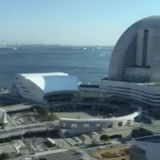I love flying the polar route to East Asia. On this flight to Japan, it was mostly cloudy but it cleared up over what I believe was Siberia and/or the Kamchatka Peninsula. There were endless white mountains and no signs of roads, villages or any form of human habitation. Completely desolate.
It cleared up again as we approached the northern coast of Hokkaido and I could see how rough the terrain was there as well. We traveled down the east coast of Japan and I think I could see Sendai, judging from my map and judging from the shape of the coastline. We headed inland and I couldn’t see Fukushima, which must have been close. One thing that strikes you from the air is that every piece of flat land is being used for something. There are rice farms everywhere. No wonder the rice farmers have such political power.
We were early, so the plane had to circle around Tokyo Bay before circling back to Narita. To all the people who think Japan has been standing still, you should see what’s happened to Tokyo Bay over the past 10 years or so. Major bridges, skyscrapers, big box retailers, etc. It has been transformed.
Which brings me to the age-old questions about what changes in Japan and is it a healthy society or is it a failing society? The superficial things don’t change. There is almost no garbage anywhere. Pedestrians still wait at a traffic light even if there are no cars coming. They won’t cross on red. Try that in New York City. There is no pollution. Everyone is dressed well. I see many fine cars on the roads including Porsches. Little guys with white gloves wearing hardhats are ubiquitous as they guide motorists around construction sites.
To me, the central symbol of how Japan continues to improve its infrastructure is the shinkasen. I was with a group of automotive writers who caught the Shinkasen from the Shinagawa station to Nagoya in central Japan. It just so happens that the following week I took Amtrak’s Acela from New York to Washington. So I can compare both from recent experience.
You enter a Japanese shinkasen station and you have no sense of crowding. You go down the right flight of stairs and the platform is marked for which car of the train will stop there. The train arrives. You step in and find your seat. But on Acela, in both New York and Washington, you have to stand in a long line before they allow passengers to file through a chokepoint and make mad dashes for the best seats on the train. The Japanese system is more sophisticated.
The shinkasen, which hit speeds of 170 mph, was also perfectly smooth. Acela was bumpy as hell. Maybe it hit a top speed of 120 mph or so. So it was also slower. The tracks have not been sufficiently upgraded.
Internet access from the shinkasen was flawless. I struggled to maintain Internet access from Washington to New York. It was spotty.
Acela in business class seemed bigger and more spacious. I’d say that’s about the only criteria on which Amtrak prevailed.
My visits to Toyota facilities also proved to me that the Japanese are innovating on a world scale, on par with the Americans and Europeans. They are an aging society, to be sure, but that does not translate into them being a failing society, as widely depicted in American news accounts. The fact that they are tolerating a decline in population is a side-effect of affluence, not failure. Japanese women are choosing to get married later in their lives or not get married at all. And the ones who do get married are choosing to have fewer children. It’s all about enhanced women’s power.
I’ve been part of this debate about Japan since my days at Business Week and the publishing of my book, The Japanese Power Game (1990.) The longer I watch Japan, from both up close and from afar, the more I’m convinced that the conventional wisdom in American intellectual circles is just plain wrong. It is a wealthy, well-ordered society that still possesses technological drive.






